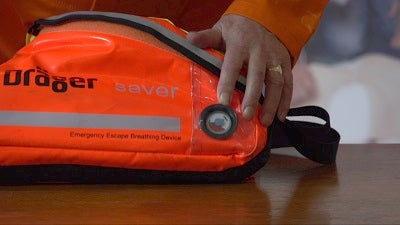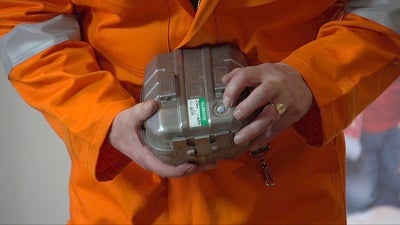Escape breathing apparatus are some of the most important equipment that you will ever use when working in confined spaces. If you need to take them onto the site, it is imperative that you understand the correct procedures for carrying and using them.
There are a number of escape sets available for use and these fall broadly into three categories:
- Compressed air with hood

- Compressed air with facemask

- Chemical oxygen


This guide focuses on inspecting, carrying and donning these three types of escape sets. Remember, the type of escape set you may be given can differ from that covered in this guide. If so, ensure that you receive the correct training in the type of escape set you are issued with at your workplace.
Also remember that it is important to don the escape set:
- If the alarm goes off
- If you are instructed to do so
- If you smell burning or see fire
Your employer will most likely select the type of escape set to be used and, in doing so, will consider:
- How far you would have to travel in an emergency
- How long it will take to get out of the confined space or to a safe area
- Whether the escape set will cause any constraints
- Whether face fit testing is necessary
Other considerations like gradients, obstacles, ladders, temperature and humidity levels, and the potential for thick smoke, may slow down wearers and increase their breathing rate, which can reduce the working time of the escape set. Therefore, selection of the correct escape set for the environment being worked in is very important.
Compressed air with hood
√ Offers between 10-15 minutes of air
√ Can be used by anybody, depending on a risk assessment
√ Easy to service and maintain and can be reused after use – is ideal for training purposes as well
X During strenuous work such as an escape, it is possible to get negative pressure inside the hood (i.e. contamination)
Pre-use Inspection

- Check the contents of the cylinder by checking that the needle on the pressure gauge is in the green section
- Ensure that the tamperproof seal is in place and intact
- Check the general condition of the carrying bag for obvious signs of damage such as rips, tears or chemical stains
- Check the shoulder strap and adjuster, ensuring no cuts or tears in the webbing, ensure the buckle is undamaged and, finally, ensure that the stitching around the bag is intact and fit for purpose
Once the pre-use inspection is complete, place the carrying strap over the head and onto the shoulder, adjust as necessary and ensure you can see the pressure gauge if required.
In the event of an emergency:
- Grasp the activation handle and the shoulder strap
- Pull upwards and outwards, this should snap the tamperproof seal and disengage the fork
- Once the unit is activated, you should be able to hear air flowing to the hood
- Remove hood from the pouch
- Don the constant flow hood by stretching the elastic collar open as shown, with both hands, pulling the hood over your head and making sure the fit is correct and secure
- Exit to a safe area
Compressed air with facemask
√ Offers between 10-15 minutes of air
√ Easy to service and maintain and can be reused after use – is ideal for training purposes as well
√ Due to the positive pressure nature of these sets, any air leakage around the face would be outwards
X Must have an effective face seal so only suitable for people who are clean shaven
Pre-use Inspection

- Check contents of the cylinder by checking the needle on the pressure gauge is in the green section
- Ensure that the tamperproof seal is in place and intact
- Check the general condition of the carrying bag for obvious signs of damage such as rips, tears or chemical stains
- Check the shoulder strap and adjuster, ensuring no cuts or tears in the webbing; ensure the buckle is undamaged and,
- finally, ensure that the stitching around the bag is intact and fit for purpose.
Once the pre-use inspection is complete, place the carrying strap over the head and onto the shoulder, adjust as necessary and ensure you can see the pressure gauge if required.
In the event of an emergency:
- Grasp the activation handle and the shoulder strap
- Pull upwards and outwards, this should snap the tamperproof seal and disengage the fork
- Remove the mask from the pouch and fit it on the face with one hand, while adjusting the position and length of the straps to fit the head comfortably and securely with the other hand
- Inhale to activate the set
- Exit to a safe area
- If you smell burning or see fire
Chemical Oxygen (Savox)
√ Offers between 20-90 minutes of air
√ Can be used by anybody, depending on a risk assessment
√ Easy to check if the unit is operational
X Cannot be reused after use so training models are required separately
Pre-use inspection

- Check container cover and bottom cover for signs of damage or heavy dirt
- Check locking device is in place and intact and that the lead seal is in place and secure
- Ensure that the moisture indicator shows blue and pink - if pink all over, then the unit should not be accepted for use
- Check label on the case and ensure the unit is in date
Once the pre-use inspection is complete, you should attach the escape set to your belt using the clip.
In the event of an emergency:
- Grasp the activation handle and push the locking device towards the arrow until the lead seal breaks and the lock and container cover fall off
- If the cover and bottom stick together, separate them manually by pulling the opening aid
- Grasp the apparatus by the orange neck strap and pull out the mouthpiece plug
- Pull the neck strap over your head and place it around your neck
- Grasp the breathing tube and firmly pull it up; this will start the escape set
- Exhale into the apparatus and fit the mouthpiece and nose clip tightly
- Adjust the neck strap to fit comfortably
- Put on the goggles, tie the waist belt and continue to breathe calmly
- Exit to safe area
If you suspect that any escape set is faulty then do not use. Remove from service immediately. Do not enter the confined space until it has been replaced.
Breathing Apparatus User Course
On our Open Circuit Breathing Apparatus training course is for those who may need to wear a breathing apparatus as part of their role – or in an emergency. Those who attend this course will learn how to inspect, put on, wear and take off breathing apparatus.





